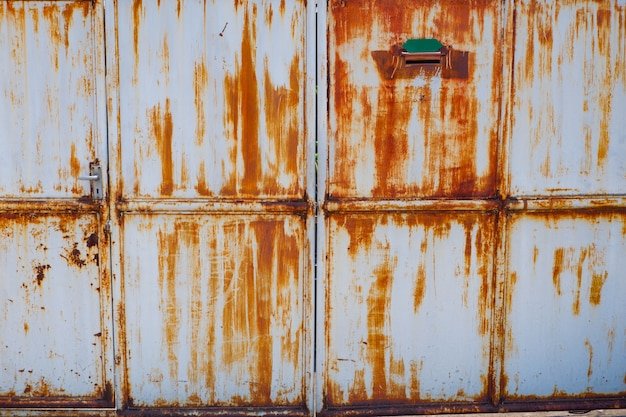
Here’s the thing: *steel* and *rust* go together like rain and puddles. Even with fancy coatings and modern materials, any steel hardware—whether it’s a keypad, deadbolt, or simple latch—can start rusting if the right conditions line up. Sometimes it happens fast, sometimes it takes a few years. But once you know why your steel door hardware is showing surface rust, you can actually do something about it. Let me walk you through what’s going on and how you can keep those spots at bay.
What Causes Surface Rust on Steel Door Hardware?
First, let’s get real about what rust actually is. Rust is simply iron oxide. It forms when iron (or steel, which is mostly iron) mixes with oxygen and moisture in the air. The process is called oxidation, and it starts on the very top layer. You might only notice a little haze or some reddish flecks at first. But left alone, it can spread and get worse over time.
Steel door hardware is usually protected with some kind of finish—powder coating, paint, even a factory wax layer in some brands like Kwikset or Defiant. But those coatings aren’t invincible. A scratch, chip, or even just slow wear from people grabbing the handle can let moisture sneak through. Once that happens, the steel underneath is exposed, and that’s all it takes for rust to start forming.
In homes near the coast, salt in the air speeds things up. Even if you’re nowhere near the beach, humidity or just regular rain can keep your steel hardware damp for longer than you’d think. The more moisture that sticks around, the faster rust shows up. Honestly, it’s a bit like leaving your favorite tools outside—give it a week, and you’ll see the same orange stains.
Why Does My Steel Door Hardware Rust, Even If It’s “Weather Resistant”?
You might be wondering, “Didn’t I buy weather-resistant or stainless steel hardware?” That’s a fair question. The truth is, no door hardware is completely immune to corrosion, even if it’s marketed as weather-resistant.
Here’s what usually happens: many brands use a protective layer—sometimes it’s a powder coat, sometimes it’s a thin layer of chromium or zinc (galvanization). These coatings make a huge difference, but if you scratch them (even a tiny nick from your keys) or if the finish wears thin, it exposes the base steel. Water, oxygen, and minerals can get through, and rust pops up right at the weak spot.
“Stainless steel” can rust, too. The steel is mixed with chromium to help stop corrosion, but if the surface gets contaminated (think: fingerprints, salty air, or even certain cleaners), it can lose its rust resistance. The lesson? *Weather-resistant* does not mean *rust-proof*. It means the hardware is better at fighting off rust, but not invincible.
Where Does Surface Rust Usually Appear on Steel Door Hardware?
Surface rust rarely spreads evenly. Instead, you’ll notice it popping up in a few classic trouble spots on your steel door hardware:
- Edges and corners – These spots take the most wear, and coatings are thinnest here.
- Around screws or fasteners – Tiny gaps or holes let water seep under the surface.
- Keypads and touchpads – Oils from fingers, plus exposure to weather, weaken protective layers.
- Bottoms of handles or deadbolts – Water naturally pools or drips here, accelerating rust.
If you look carefully at Schlage, Yale, Defiant, or even off-brand locks, you’ll often see the first signs of rust in these areas. It happens even faster if you use abrasive cleaners, rough sponges, or metal polish that takes off the clear coat.
In some cases, hardware will rust more quickly if the outer finish is damaged during installation. Screwdrivers, drills, or even a misplaced ring can scratch through a coating. And once a small patch starts rusting, it can spread beneath the finish unseen—sort of like mold under old bathroom tile.
How Does Weather and Location Affect Steel Door Hardware Rust?
Let me explain: weather plays a much bigger role in rust than most people think. If you live in a humid climate, your door hardware is dealing with moisture all year round. Every bit of rain, fog, or even dew can leave a thin film of water that gives rust exactly what it needs to start forming.
Salt in the air is kryptonite for steel. If your home is anywhere near the ocean, or even a salt-treated road in winter, that salt speeds up the rusting reaction by a mile. It’s why you see so many rusty doorknobs on beach houses—even if the hardware is technically “outdoor rated.”
Temperature swings can actually make things worse, too. On a chilly night, water can condense on your door hardware and then evaporate during the day, repeating over and over. This cycle lets moisture sneak into tiny cracks, which is bad news for your hardware’s life span.
If your door faces the sun for most of the day, UV light can break down protective coatings faster, leaving steel exposed. Wind-driven rain can force water into seams where it wouldn’t normally go. Basically, your local weather is always quietly working against your steel door hardware.
Can You Prevent Surface Rust on Steel Door Hardware?
Here’s the good news: *you can slow down rust a lot, and sometimes stop it completely*. The key is maintenance and a little bit of attention to detail.
- Keep things dry. Use a towel to quickly wipe off rain, dew, or condensation. Even a fast swipe after a storm is better than nothing.
- Avoid abrasive cleaners. Stick to soft cloths and mild soapy water. Harsh cleaning pads can scratch protective layers without you even realizing it.
- Wax or oil your hardware. Applying a light layer of furniture wax, car wax, or specialty hardware oil adds an extra barrier. Buff it in well and reapply every few months.
- Check finishes often. Look for scratches or worn spots, especially near moving parts. If you spot damage, touch up with a matching finish or a clear coat to block moisture.
If you’re installing new hardware, handle it with gloves or clean hands to avoid fingerprints. Small details matter more than you think—a single fingerprint can sometimes start a rust spot on “stainless” steel.
For homes in harsh climates, you might want to consider hardware made from *solid brass* or *bronze* instead of steel. These metals don’t rust in the same way, though they can tarnish or discolor over time.
What Should You Do If Rust Has Already Started?
If you see the first signs of surface rust, don’t panic or assume you need to replace everything. Surface rust is usually shallow and can be removed with a bit of patience.
- Clean the area. Gently wash with mild soap and water to get rid of dirt and grime.
- Use a rust remover or make a paste from baking soda and water. Apply it to the rusty spot and scrub with a soft brush or cloth.
- Rinse and dry thoroughly. Don’t leave any cleaning residue behind.
- Protect the cleaned area. Once dry, apply a thin layer of wax, oil, or a clear protective spray to block future moisture.
For deeper rust that won’t scrub away, you might need to sand lightly or use a fine steel wool pad—very gently, and only on the affected spot. Be careful not to damage any nearby finish.
If the rust is inside moving parts (like the lock cylinder), it might cause sticking or jamming. In that case, you can apply a drop or two of lubricant designed for locks (think Graphite or Tri-Flow), and work the hardware back and forth to spread it around. Avoid WD-40 unless you know the brand recommends it, as it can wash away important long-term lubricants.
Do Different Brands Make a Difference With Rust Resistance?
You might be comparing Schlage, Yale, Defiant, Kwikset, and even no-name import hardware and wondering if some brands handle rust better than others. Here’s what I’ve seen: there *are* differences, but they’re not as big as marketing suggests.
Premium brands like Schlage or Yale often use more durable coatings, and sometimes better base materials, which helps. They may have tighter tolerances so water can’t easily seep in. But even the best brands aren’t magic—if the finish is damaged, rust still happens.
Budget brands, or “universal fit” hardware found at big-box stores, might have thinner coatings or even bare steel backs where you can’t see. These will rust much faster, especially in harsh weather. If you’re shopping for new hardware, take a close look at those hidden parts and the feel of the finish.
In the end, it’s the *care* and *location* that matter more than the logo on the box. If you’re in a salty, humid, or rainy area, springing for a higher-end finish can make a difference. But no brand is truly rust-proof if the environment is challenging enough.
When Should You Replace Rusty Steel Door Hardware?
Here’s where it gets tricky. Light, surface rust is mostly a cosmetic problem—not a reason to panic. You can usually clean it up and get a couple more years out of the hardware with regular maintenance. But if the rust is spreading deep, flaking, or weakening the actual structure of the latch or lock, it’s time to think replacement.
- If the key sticks, the handle wobbles, or moving parts grind or catch, rust may be affecting the inner workings.
- If the rust goes under the finish and starts bubbling or breaking away in big patches, the hardware’s strength is likely compromised.
- If the rust causes discoloration that keeps coming back after cleaning, it may be time to switch to a more rust-resistant option.
Don’t forget—old, rusty hardware can be a security risk. Door locks and handles are your first line of defense, so if something feels off, it’s worth upgrading sooner rather than later.
When replacing hardware, you’ll find there are non-steel alternatives, including solid brass, bronze, and some weatherproof composites. These can cost more, but if you’re tired of dealing with rust, they’re worth the investment.
If you’re constantly fighting surface rust on your steel door hardware, it might just be your home’s climate or the spot your door faces. Sometimes, it’s not about what you did wrong—it’s just the way nature works on steel.
Final Thoughts: Dealing With Surface Rust on Steel Door Hardware
Surface rust on steel door hardware isn’t a life sentence for your front door or an automatic reason to replace those Schlage or Kwikset handles. It’s mostly a natural reaction between metal, air, and water—something every homeowner runs into eventually, especially in tough climates or after a couple of years of daily use.
The key takeaway? Rust is normal, but not unstoppable. Regular cleaning, careful use, and the occasional bit of preventative care can slow it down or even keep it away for a long time. And if your hardware is already showing a little orange, you’re not alone—just follow a gentle cleaning routine and keep an eye out for bigger problems.
If you learn your climate is extra tough on steel, consider switching to a more rust-resistant material next time. Until then, a bit of elbow grease and attention goes a long way in keeping your entrance looking sharp and working smoothly. Your door hardware does a lot of heavy lifting every day—give it some care, and it’ll return the favor for years to come.
